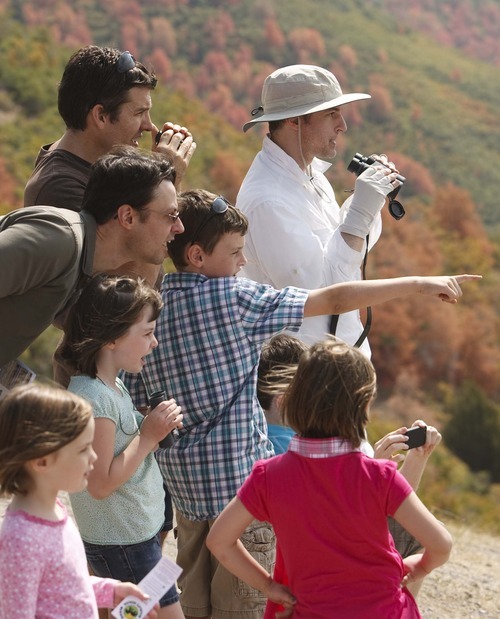This is an archived article that was published on sltrib.com in 2012, and information in the article may be outdated. It is provided only for personal research purposes and may not be reprinted.
Orem • With a chorus of one-two-threes to help it on its way, a turkey vulture beat its massive wings, sank to the ground in front of a crowd of well-wishers and took off into the smoky atmosphere in the hills above Orem on Saturday.
The bird, gender undetermined, was one of three vultures, a Cooper's hawk and a Swainson's hawk released by members of Great Basin Wildlife Rescue, a tiny group of volunteer and licensed animal rescuers who rehabilitate and release hundreds of injured birds back into the wild every year.
"It's just amazing," said Andalya Hall, 15, a Great Basin volunteer and student at Springville High School, who released another vulture. "After helping with these birds, to feed them, clean their pens, weigh them and then get to release them is such an amazing feeling."
In one way or another, each of these raptors — yes, vultures are raptors, just like hawks, falcons and eagles — would have met an untimely end if it hadn't been for Great Basin's volunteers. Two vultures had been shot; the third was found with a broken wing. The Swainson's hawk tumbled from its mother's nest when it was a chick. The Cooper's hawk had been struck by a golf ball and, after being released once before, crashed into a Great Basin building last week.
"You would be surprised at the number of birds that have been shot," said Patti Richards, Great Basin's executive director. "At least 50 percent have buckshot in them."
The birds were released at the Squaw Peak Overlook, some 1,800 feet above Orem. As each ascended into the air in search of thermal drafts gusting up from the valley, Sarah Stanley, 10, watched intently.
"I thought it was awesome," the Lehi girl said. "I really like birds of prey. They can fly really well. I really like to see birds fly. They just look so pretty."
Equally impressed was Blake Pelton, a paraglider from Draper, who happened onto the scene by chance. He and some buddies were waiting patiently for the releases to conclude so they could go flying, too.
"The birds show us the lift, and we show them the lifts, too," said Pelton, who added that many times he and his feathered neighbors ride the air currents together. "It's a mutual relationship."
Richards claims Great Basin is able to successfully release 80 percent of the birds that members rehabilitate. Those deemed unfit for the wild are donated to zoos.
Said Rebecca Farnsworth of the releases and the work that her friend Richards has done for a decade: "I think it's a lovely experience. It makes my heart soar because the birds are able to go back to their natural habitats.
"They aren't dead. They get to do what they are meant to do," Farnsworth said.
Twitter: @sltribpaul —
More online
To learn more about the Great Basin Wildlife Rescue, visit http://greatbasinwildlife.net/greatbasin_mission.html.



